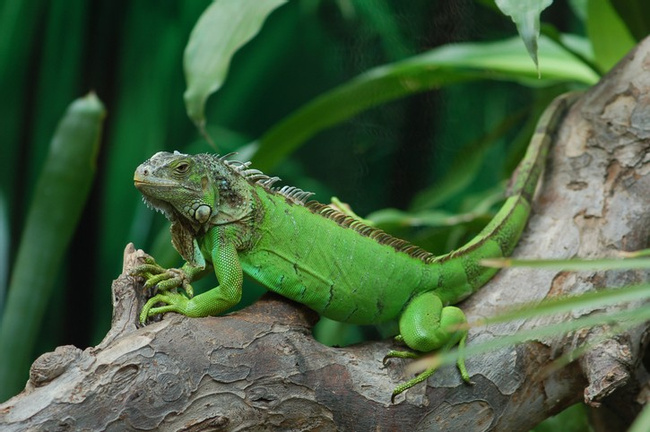Green Iguana
The green iguana (Iguana iguana) is one of the largest lizards in the Americas—they can grow up to 6.5 feet long (2 m) and weigh 11 pounds (5 kg). They are also common pets in the United States, despite the fact that they are difficult to care for.

More about Green Iguana
Habitat
Green iguanas live in the rainforests of northern Mexico, Central America, the Caribbean Islands, and southern Brazil.
Physical Description
Green iguanas have a long body covered with green leathery scales. They have sharp teeth and short legs. Each foot has five toes with sharp claws used for climbing. There is a row of spines extending from their head to their tail.
Their long tails make up over half their body length and are sometimes used to drive away predators. The tails can even be detached if they are caught; if this happens, green iguanas will grow a new tail without any long-lasting damage.
Green iguanas have two nostrils that are used to expel a saline solution that helps regulate their body’s salt level.
Interesting Biology
Green iguanas usually live close to water and are wonderful swimmers. If a green iguana is threatened while in the canopy, it will jump from the trees and escape into the water below. They can stay under water for up to 30 minutes. Incredibly, they are also sturdy enough to jump from 40 feet (12 m) onto the ground and survive.
Green iguanas are arboreal and terrestrial. They live in trees near rivers, lakes, and mangrove swamps. They are diurnal and feed during the day.
In the wild, green iguanas can live up to 20 years. They are a social species; groups of iguanas may be found basking in the sun or searching for food.
The mating season usually occurs in the fall and lasts several weeks. During this season, males become more aggressive. Outside of the mating season, iguanas are less active and tend to spend most of their time resting.
Females lay their eggs in sandy nests and move from their home site to the nest site daily. They travel along a nearly identical path between their home site and the nest each day. Females may travel almost 2 miles (3.2 km) to find a nesting site.
The clutch of eggs is typically between 12 and 30 eggs. After 90 days, baby iguanas hatch. They are 1-foot long when they hatch and quickly disperse after hatching.
Diet
Green iguanas are herbivores that feed on flowers, leaves, and fruit. When foraging, green iguanas will return to the same foraging site each day.
Height/Weight
Green iguanas range from 4.9–6.6 feet (1.5–2 m) and can weigh up to 11 pounds (5 kg).
Brief Taxonomy
Order: Squamata.
Family: Iguanidae.
Sources
"Iguana iguana, Common Green Iguana." University of Michigan, Museum of Zoology. Animal Diversity Web.
"Green Iguana, Reptiles & Amphibians Facts Sheet." Smithsonian National Zoological Park website.
"Green Iguana." National Geographic, Animals Reference. National Geographic website.
Similar Profiles
We believe travel is more than ticking destinations off a list – it’s about discovering new places deeply, feeling connected wherever you go, and knowing you have a trusted team behind you every step of the way.



